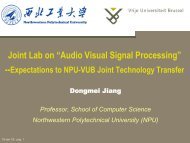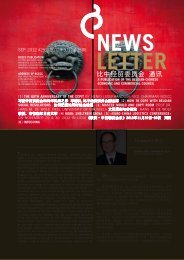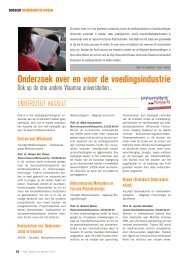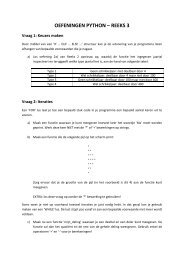least squares theory and design of optimal noise shaping filters
least squares theory and design of optimal noise shaping filters
least squares theory and design of optimal noise shaping filters
You also want an ePaper? Increase the reach of your titles
YUMPU automatically turns print PDFs into web optimized ePapers that Google loves.
Verhelst <strong>and</strong> De Koning Least Squares Noise Shaping<br />
tems use a dithered quantizer <strong>and</strong> others use non-dithered<br />
quantizers. With our proposed <strong>theory</strong>, we are basically<br />
able to cope with both situations. It is at present, however,<br />
not clear whether a dithered or non-dithered quantizer<br />
should be used with <strong>noise</strong> <strong>shaping</strong>.<br />
Dither increases the error power, but decorrelates the error<br />
from the signal. On the other h<strong>and</strong>, not all types <strong>of</strong><br />
correlated error would necessarily be harmful (as an example,<br />
the correlation would be at the extreme if the error<br />
is a fraction <strong>of</strong> the signal itself, but this error would not<br />
distort the signal). Also considering that the requantization<br />
error can be spectrally shaped such that it is <strong>optimal</strong>ly<br />
masked, the strategy <strong>of</strong> psychoacoustic <strong>noise</strong> <strong>shaping</strong><br />
could perhaps allow for minimally audible requantization<br />
without dithering.<br />
Further experience <strong>and</strong> experiments should be used to decide<br />
which perception models can best be applied, what<br />
type <strong>of</strong> quantizers should be used (e.g., dithered or nondithered),<br />
what <strong>noise</strong> <strong>shaping</strong> filter orders to use, etc.<br />
These <strong>and</strong> similar questions relating to parameter optimization<br />
are still open for further research. It is our impression<br />
that different <strong>optimal</strong> conditions could apply for<br />
different applications (bit precision, signal type <strong>and</strong> b<strong>and</strong>width,<br />
...).<br />
ACKNOWLEDGMENTS<br />
Support from the Flemish Community through grants from<br />
IWT <strong>and</strong> FWO is gratefully acknowledged.<br />
The first author thanks Robert Bristow-Johnson from Wave<br />
Mechanics for the stimulating e-mail correspondence that<br />
we had on the subject.<br />
REFERENCES<br />
[1] Roads, C., The Computer Music Tutorial, third<br />
printing, pp. 33-38, MIT Press, Cambridge, Massachussets,<br />
1998.<br />
[2] Lipshitz, S.P., V<strong>and</strong>erkooy, J., <strong>and</strong> Wannamaker<br />
R.A.,”Minimally Audible Noise Shaping”, J. Audio<br />
Eng. Soc. 39 (11): 836-852, 1991.<br />
[3] Wannamaker, R.A., ”Psychoacoustically Optimal<br />
Noise Shaping”, J. Audio Eng. Soc. 40 (7/8): 611-<br />
620, 1992 - presented at the 89th AES Convention,<br />
Los Angeles, September 21-25, 1990.<br />
[4] Wannamaker, R.A., Lipshitz, S.P., V<strong>and</strong>erkooy, J.,<br />
<strong>and</strong> Wright J.N., ”A Theory <strong>of</strong> Nonsubtractive<br />
Dither”, IEEE Trans. on Signal Processing 48 (2):<br />
499-516, February 2000.<br />
[5] Akune, M., Heddle, R.M., <strong>and</strong> Akagiri, K., ”Super<br />
Bit Mapping: Psychoacoustically Optimized Digital<br />
Recording”, AES preprint 3371, presented at the<br />
93rd AES Convention, San Fransisco, October 1-4,<br />
1992.<br />
[6] Verhelst W., <strong>and</strong> De Koning D., ”Noise Shaping Filter<br />
Design for Minimally Audible Signal Requantization”,<br />
proceedings <strong>of</strong> WASPAA-01, 21-24 October<br />
2001, New Paltz, New York.<br />
[7] Gerzon, M., <strong>and</strong> Craven, P.G., ”Optimal Noise<br />
Shaping <strong>and</strong> Dither <strong>of</strong> Digital Signals”, AES<br />
preprint 2822, presented at the 87th AES Convention,<br />
New York, October 18-21, 1989.<br />
[8] Markel, J.D., <strong>and</strong> Gray, A.H.Jr., Linear prediction<br />
<strong>of</strong> speech, Springer Verlag, New York, 1976.<br />
[9] Deller, J.R. Jr., Proakis, J.G., <strong>and</strong> Hansen, J.H.L.,<br />
Discrete-Time Processing <strong>of</strong> Speech Signals, Chapter<br />
5, Macmillan, New York, 1993.<br />
[10] LeRoux, J., <strong>and</strong> Gueguen, C., ”A fixed point computation<br />
<strong>of</strong> partial correlation coefficients”, IEEE<br />
Transactions on Acoust., Speech <strong>and</strong> Signal Processing:<br />
257-259, June 1977.<br />
AES 22 Ò� International Conference on Virtual, Synthetic <strong>and</strong> Entertainment Audio 7






